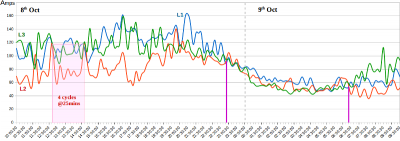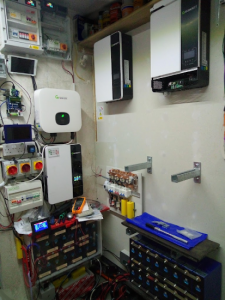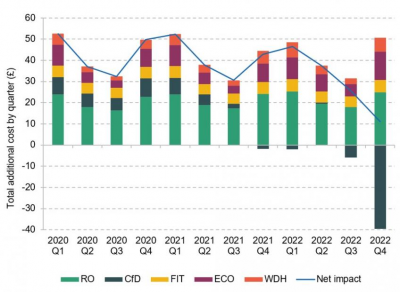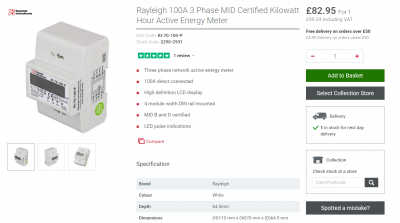No spare parts for Vaillant Ground Source Heat Pumps in the UK & major corrosion issue is another problem for GSHP
It's interesting what you say. We didn't understand how Octopus deals with exports when we signed up. We signed up with them because they provide "Outgoing Octopus" which pays on the basis of the market value of energy, adjusted every 30 minutes. This gives us an export payment per kWh of about 5 x what Good Energy was paying us based on the government export tarrif, which has barely changed since energy prices skyrocketed. The FAQs on Outgoing Octopus can be found here
https://octopus.energy/outgoing/
Prices actually paid can be found here (not a secure site)
http://mysmartenergy.uk/Prices/South-West-England#OutgoingGraph
We have a dashboard on Octopus's website, as well as an app, that reports exports every 30 minutes, and separately reports imports every 30 minutes. Octopus adjusts our import bill by deducting our export earnings, and itemizes everything to the nth degree on the statements - how much we earned every 30 minutes and how much we spent every 30 minutes. If we have net negative (net exports), they pay us for the amount we exported after imports are deducted.
Who provides your export payments, then?
Good Energy has a yearly contract that says that you can't cancel the contract until 30 days before the contract expires. This is, by UK trading standards, and 'unfair' contract that prejudices the consumer. I told them that their contract was, in fact, illegal. They continued to insist that I couldn't switch export payment providers. You can, at any time, however, change FIT providers (it doesn't cost Good Energy anything if you change FIT providers). Finally, Good Energy accepted that I could switch to Octopus. When I did this, Octopus told me I was stuck with the government export tarrifs, and then later corrected this - I could indeed move from the government export tarrif to the Octopus Outgoing tarrif, which is what I am now on.
I have something new to report. The Ground Source Heat Pump Association told me, when I asked them about corrosion prevention guidelines/methods, that: "We support the industry and our members in many ways but as a trade association we do not issue or publish any specific GSHP installation/maintenance guidelines therefore we are unable to help you as such any further."
I then spoke with Chris at Hydratech.co.uk, which manufactures specialist products for Ground Source Heat Pumps that serve as both anti-freeze (glycol substitutes) and corrosion inhibitors. He informed me as completely as possible about the problems and how to prevent/solve them. I take the liberty of providing that advice here:
Apologies for getting confused about which pumps you have on your GSHP @phowardstutterheim
Once a property is fed with 3-phase, then the electrician should try to assign the load as evenly as possible across the phases. This requires a modicum of common sense because our in-house appliances will still be single-phase of course. Few people would want to switch to a (commercial) 3-phase deep freezer!
Because 99.9% of our local substations are un-monitored, we have for too long remained blissfully ignorant of the losses due to phase imbalance. However, I'm a member of a group of 8 community organisations who have access to data from 16 substations with live monitoring. Here's a time-graph showing the current drawn from the 3-phases on just one feed from such a transformer:
The phases are equally loaded in the middle of the night between the two magenta lines. But Phase-L2 draws far less current from the grid than L1 & L3 during daytime, due to houses fed by it having more solar panels.
You can also see the characteristic 'cycling' of a single-phase heat-pump being used, also on L2.
Losses due to phase imbalance is running at around 10% on domestic properties nationally.
Those losses have more than doubled since the Government introduced FIT subsidies for home-owners to install solar panels.
That's the problem with politicians making decisions which aren't properly supported by the underlying physics!
I obviously need to start a separate discussion topic on Issues with Smart Meters. I'll put a link here once I've written and posted the introductory 'chapter'.
Don't be daunted by the subject. The majority of what I'll be posting is graphics!
Diagrams, photos and graphs are so much easier to understand 😀
Battery Storage. If your husband has the acumen to design a greenhouse with commercial potential, then he already has a lot of the skills and tools required to build your own set of storage batteries.
That would cost around £4000 for a 'set'; hybrid solar/grid inverter, 14kW of lithium cells, Battery Management System, cables, trips etc.
You'd require three such inverters for a 3-phase installation, with as large a set of batteries as you can reasonably afford.
Here's a view of my own 'plant room' as of this morning. The wall to the left has been operating over the last year, and the larger wall beside it is being prepared to receive two or three more 14kW batteries with a couple more inverters above them.
All of the required details of suppliers and strategy will be discussed here on the Forum.
That will enable others to also copy what's required.
Yes, by all means wait until September to switch to a Time-of-Use tariff.
But for next winter you'll be able to use your solar panels and store mains electricity at around one-third the 'standard' price.
That will make a significant dent in the running costs of your GSHP.
Save energy... recycle electrons!
I don't get paid for exporting energy other than through the FIT payment export payment. Since I only have a 4kW solar PV system, I try to use as much as possible of the generation internally, so actually export the minimum amount.
I seem to remember when I looked at Outgoing Octopus, that I would lose the FIT payments if I made the switch, which would not be financially advisable, since the present FIT payments total something in the order of 60p per unit generated.
@derek-m That's what we were told initially, but it is untrue - you will not lose the FIT payments if you switch to Octopus Outgoing for Exports. We would never have been able to switch if this was the case.
@transparent We will definitely look into the battery system that you are describing, and will follow any related discussions to get this installed by next winter!
You are correct @phowardstutterheim - the FIT payments are handled independently of which tariff you sign up to. They simply get administered by your chosen Energy Supplier because they have the ability to read the meter... although most still insist on receiving manual export readings from homes with Smart Meters.
@derek-m must've signed up for the FIT scheme very early on to get 60p/kWh. The payments were gradually reduced over the years.
There is also an ethical issue at stake here.
The FIT payments come from a levy on everyone's electricity bills.
There are similar levies which get paid into schemes to increase insulation levels and trial new technology.
Levies account for about 8% of our bills.
But the vast majority of the homes which installed solar panels during the years of the FIT scheme are owned by the wealthiest people in the UK. They were owner-occupiers and had roofs which were sufficiently large.
That means the burden of supporting 25-years of FIT payments falls more onto those who are currently suffering energy-poverty.
So it's not just the extra losses on the distribution grid due to phase-imbalance which we are all now having to fund, but also the moral imbalance of where the FIT money comes from.
Few people realise how their energy bills are calculated, so there is very little public dissent.
But in truth, Government-backed schemes to increase the uptake of renewable energy have resulted in an unfair proportion of the money being required from those who are least able to afford it.
Save energy... recycle electrons!
We are not wealthy and we receive the FIT subsidies that you mention, as do all households that installed Solar PV under the scheme. Of course, those who installed the most PVs benefitted the most, although the amount of the per kWh generation subsidy is related to the amount of kWh generated, and drops 'proportionately' when reaches 'commercial' levels.
What this does not consider is the amount that UK taxpayers pay for oil and gas subsidies, as discussed here:
Also, the latest information shows that the subsidies provided for 'green levies' are being counteracted by higher energy prices: "Taken together, Ofgem has estimated that various levies and obligations on energy companies, as of the summer of 2022, impose an additional cost of £153 per year on the energy bills of a typical household...this figure will overstate the cost of these levies when energy prices are high. This is because the way in which zero-carbon energy generation is subsidised in the UK means that the cost of subsidies to the bill payers falls as electricity prices rise...taken together, the total net cost of these levies is expected to be just £11 to the typical household’s bill over the three months beginning 1 October – a figure eclipsed by the additional £490 such a household can expect to pay over the next 3 months as a result of today’s price cap rise"
One way to stimulate the renewables sector and to gain public approval, as the Germans have learned, is to install solar, wind turbines, and ground source heat at scale to benefit entire communities - not individuals - such as 'energy parks' - see
https://www.uka-gruppe.de/en/citizens-and-communities/
This article presents the German approach to renewables, which also looks at how to shift costs away from vulnerable consumers while achieving net zero:
https://www.cleanenergywire.org/factsheets/germanys-2022-renewables-and-energy-reforms
There is a lot to know, and a lot to learn to get the policies right - and there is NO more urgent problem than this.
You are indeed correct, the factor which convinced me, and more importantly my wife, to invest in a solar PV system was the generous FIT payments being offered at the time, and I managed to get a system installed just before the rate was lowered. I probably would not have done so, had it not been for the fact that I was working on contract to EDF at the time, on the construction of the CCGT power station at West Burton, and received an e-mail on the internal system providing details of the scheme.
At the time I probably paid twice the price that a similar sized system would cost today, a large portion of the 'bribe' therefore going to the installer. Does that sound familiar with relation to heat pumps?
I would not term myself as being rich, in fact I often claim that I suffer from those twin evils of 'old age' and 'poverty', though I suppose poverty is more a measure of how expensive one's wife is to maintain. 🙄
The FIT payment that we receive is made up of two elements, the first being the larger part which is a payment for all electricity units generated, the second payment, at a much lower rate, is for half the total units generated, which are deemed to have been exported, since there was no actual export meter installed.
There is a dedicated FIT meter, which is not Smart, the readings from which I enter in the EDF website every three months, since EDF is the energy supplier with whom I am registered under the FIT scheme.
Over the years I have been investigating, and developing, more and more ways to utilise as much solar PV generation within our home as possible, both from a financial aspect and to reduce our export to the grid. The installation of a power diverter, the use of an electric convection heater, and more recently the installation of an A2A heat pump all serve the purpose of helping to balance the grid. My next objective is battery storage.
I fully agree that the politicians involved probably did not fully understand, or more likely just ignored, the concerns of Engineers within the electricity distribution system, about the probable effects as the number of PV systems increased. Because, as far as I am aware, there has never been an overall plan, some areas of the country may suffer worse than others when it comes to the imbalance problems.
The imbalance problem will no doubt become worse as more and more heat pumps, EV chargers and battery storage systems are installed by the 'rich'.
There are possible solutions, connect all high demand or high generation homes to a three phase supply, or allow the DNO's to install a local battery storage system, that is not only able to store PV generation from homes in the vicinity, but can also move power from one phase to the other to reduce the imbalance.
Posted by: @phowardstutterheimWe are not wealthy...
Well, certainly not now - no!
Most of your capital has been taken by your GSHP installers! 😥
Your point about the German approach to community-based energy is well made.
We do have similar opportunities in the UK, however.
Local Energy Groups can form a Community Interest Company and operate as an energy Aggregator.
They can own renewable energy assets themselves, and/or pay for electricity exports and heat-sources owned by their members.
There's an online energy trading platform called Piclo which is used by many such Aggregators to bill their membership for energy, whilst complying with the legislative requirements.
That's another topic which needs discussing with your local Hythe Environmental Community Group.
Save energy... recycle electrons!
Posted by: @phowardstutterheim....and we don't have any way to measure the total electricity use of the GSH system we have installed - from borehole to GSHP/boiler). If you have any suggestions on how to go about this, we would be very happy to hear.
An Electrician will be able to fit a meter to your gshp system, and I think it's the first step in understanding if it is functioning well. I understand it's 3 phase - that's ok, 3 phase meters exist! I recommend one that is wired in place, there are plenty that are MID certified. MID means they must be accurate enough to be used for billing purposes - not that you will be doing this. Below I've put a pic of one, I just googled "MID certified 3 phase meter", the one I picked isn't special. Given you've got a hefty borehole pump, you might consider a separate single phase meter on that too, while you're at it - these are cheaper.
We have a gshp, tiny compared to yours (2.4kW), and a little MID certified meter constantly totting up how much electricity it uses. I think the little single phase one I got was £20 on amazon, din mount.
- 26 Forums
- 2,342 Topics
- 53 K Posts
- 143 Online
- 6,000 Members
Join Us!
Worth Watching
Latest Posts
-
RE: Poll for Time of Use, tariffs, technology
I ticked Intelligent and Agile, I'm on Agile at the mom...
By JohnnyB , 3 hours ago
-
RE: Has Anyone Else Noticed a Decline in Tradesmanship?
I am coming towards the end of a new house build (why I...
By JohnnyB , 3 hours ago
-

RE: What a Bad Heat Pump Installation Looks Like
@editor The trick to an inside unit installation is to ...
By MikeFl , 6 hours ago
-
RE: Different dT on each radiator?
The way heating systems are designed will result in rou...
By JamesPa , 9 hours ago
-
RE: Heat Pump Performance Analysis Web App using Modbus Data
I have created a beginners guide to provide a walkthrou...
By redzer_irl , 13 hours ago
-

RE: Setback savings - fact or fiction?
PS by visually merging the two tables as above, I ended...
By cathodeRay , 18 hours ago
-
RE: Samsung ASHP scheduling help
Correction to the post above (my time to edit has run o...
By redzer_irl , 19 hours ago
-

RE: Homely for Daikin Altherma 3 - Petersfield Area
@russ If you would care to pose your questions on one o...
By Toodles , 20 hours ago
-

RE: A Smarter Smart Controller from Homely?
@papahuhu I have a feeling that my Homely smart control...
By Toodles , 20 hours ago
-

RE: The good, the bad and the not that great – my heat pump installation
@cathoderay the guy I spoke to on the phone seemed very...
By Burtis , 1 day ago
-
RE: Configuration issues with 10kW Midea R32 heat pump
Sorry that was a screenshot of @curlyKatie - mine has...
By SteveT , 1 day ago
-
RE: British Gas vs Octopus Energy vs Heat Geek vs EDF vs Aira vs OVO vs EON.Next vs Boxt
I get the impression that that comment "they don't comm...
By JamesPa , 2 days ago
-

@majordennisbloodnok Just in case there are variations ...
By Toodles , 2 days ago
-

RE: Latest NIBE model has known defect and no solution
@kings I’m glad I could help. NIBE are taking this very...
By Mars , 2 days ago
-
RE: Octopus Cosy Heat Pump Owners & Discussion Thread
@jamespa yes, I'm under no illusions but in some respec...
By AndrewJ , 2 days ago
-
RE: Electricity price predictions
It seems the end of cfd payments is in sight, even if a...
By Batpred , 2 days ago
-
-
@pie_eater Yes, I installed Homely to a Daikin heat pum...
By gery , 2 days ago
-
RE: Havenwise App Help & Forum Support – Get the Most from Your Heat Pump
@davidalgarve Potentially stupid question, but are you ...
By Sheriff Fatman , 2 days ago









